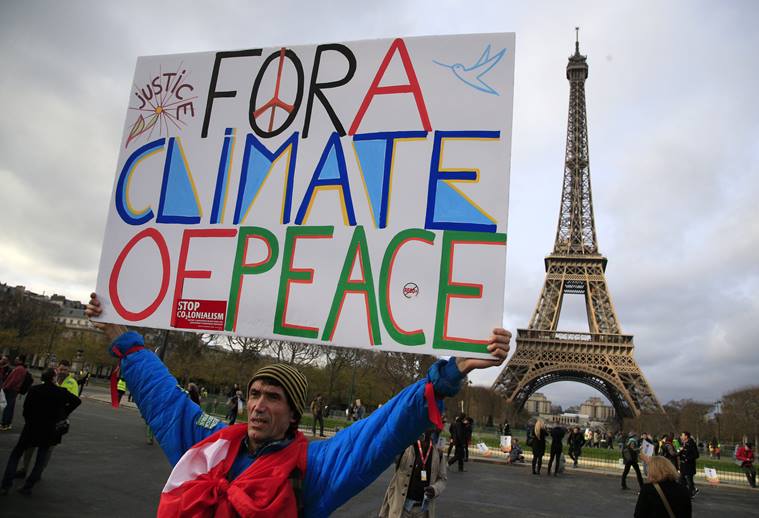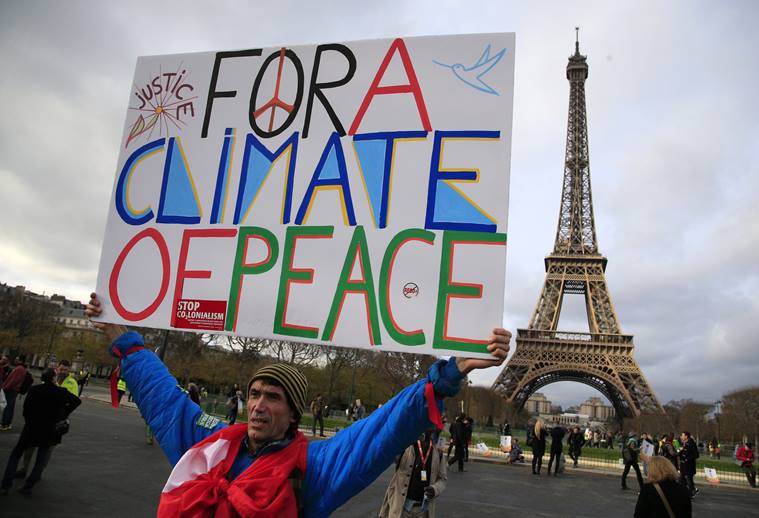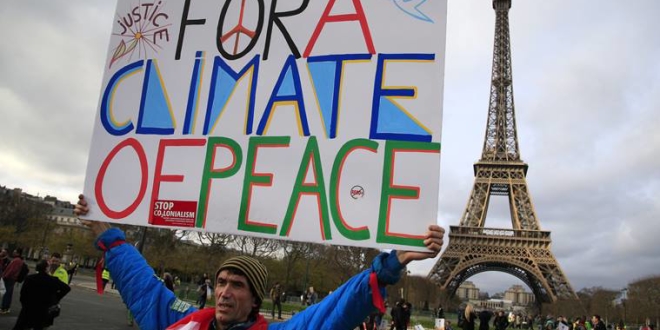

In ‘The Paris Template’ (The Indian Express, November 30), I had argued that a successful outcome was assured mainly because the bar had been set very low. I had also envisaged the possibility that a last-minute deadlock would be broken by a take-it-or-leave-it draft presented by the French hosts that the by-then exhausted delegations would be persuaded to accept. This has come to pass with an agreed outcome document on the basis of a “final draft” presented by the French. It was adopted by consensus amid resounding applause. But the jubilation was more out of a sense of relief than accomplishment. It consists of two parts: A decision of the Conference of Parties (CoP) to the UN Framework Convention on Climate Change (UNFCCC), which is non-binding, and a Paris Agreement, which when signed and ratified will constitute a legally binding agreement.
What is “legally binding” in the Paris Agreement? It institutionalises a “pledge and review” system, whereby countries are committed to offering voluntary climate change actions that would then be subject to periodic (in this case, five yearly) reviews, but with no penalties for not achieving these voluntary targets. But why go to all the trouble to have a legal agreement if this is all that it seeks to achieve?
The importance of having a legal agreement lies in the framework it lays down, on the basis of which countries will pursue climate change action post 2020. Western nations, particularly the US, were determined to put in place a legal instrument that would, in key aspects, supplant the existing climate change treaty, the UNFCCC, which was adopted by consensus in Rio in 1992. The Paris Agreement departs significantly from the UNFCCC, even though it is, technically speaking, under it. The Paris Agreement emerges as a parallel legal instrument with its own mechanisms and procedures for implementation outside the Rio Convention. The CoP to the Paris Agreement also has an identity separate from the CoP to the convention. It is the Paris Agreement that will provide the template for future climate change action and not its parent, the Rio Convention. This is a loss for developing countries because the convention is a much stronger instrument, recognising the historical responsibility of developed countries for global warming. It placed the major responsibility for reducing greenhouse gas emissions on them and put in place a robust compliance mechanism. Climate change action by developing countries was conditional upon receiving finance and technology from developed countries, as entitlements, not as foreign assistance. If one goes through the Paris Agreement, it will be apparent how far we have travelled from that original compact reached in 1992. In fact, the very notion of historical responsibility is absent and with it, the idea of a certain obligation on the part of developed nations to do more themselves and to enable developing countries to undertake mitigation and adaptation.
It is true that countries like India have been successful in maintaining some of their red lines and should be commended for it. The principles of equity and common but differentiated responsibilities have been reaffirmed. This will enable us to insist on equitable burden-sharing in future climate change actions. But there is no legal distinction between developed and developing countries as Annex I and non-Annex I countries, respectively, as under the convention. Differentiation is also time bound in the sense that the Paris Agreement expects all countries to peak their emissions as soon as possible and then undertake economy-wide reductions, though developing countries are allowed to peak later than developed countries. In the convention, only the latter were expected to do so, not developing countries.
There is also a provision for a common, though flexible, metric, still to be worked out, to evaluate performance of both developed and developing countries. This, too, dilutes the differentiation principle. In some respects, however, one finds the outcome better than anticipated. The fact that it has been approved by all 190-plus countries lends to it a degree of international legitimacy that is critical to meeting the challenge of climate change. One should also welcome the principle of “progression” embedded in the agreement — that is, there cannot be any backsliding from targets already submitted. At each round of review, there will be an expectation of higher ambition. Since current intended contributions, in the aggregate, are less than half of what is required to limit temperature rise to less than 2 degree Celsius, higher ambition in future is imperative. It is important that this progression principle also applies to climate finance. The already committed $100 billion by 2020 will become the baseline for future. But it is not at all clear how much of this will come out of public sources since private and institutional flows are uncertain and unpredictable.
For India, Paris was a holding operation, to stop the attrition process in play since Copenhagen in 2009, which led, through successive annual CoPs, to the virtual hollowing out of the convention. The Paris Agreement is a pale shadow of the convention, but our negotiators at least salvaged some key principles such as equity and differentiation that were in danger of being obliterated along with the notion of “historical responsibility”. They stood their ground against difficult odds. The focus will now shift to the several mechanisms and procedures that have to be put in place to give effect to the Paris Agreement. This will include the methodology for measuring net emissions during the five-year review and the nature of the flexibility that is available to developing countries in this regard. The issues of finance and technology transfers remain unresolved. The formulations in the Paris Agreement on them are mostly in the nature of exhortations rather than substantive. We must ensure that this follow-up exercise does not undermine some of the few gains we have managed to salvage at Paris.
![]()
Source: New feed






